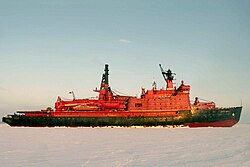Arktika (ship)
|
Atomic icebreaker Arktika
|
||||||||||||||||||||
|
||||||||||||||||||||
|
||||||||||||||||||||
|
||||||||||||||||||||
The nuclear-powered icebreaker Arktika ( Russian Арктика ) is a Russian nuclear-powered icebreaker of Arktika class , which was designed for work in polar regions. This is the successor to Lenin .
history

On December 26, 1972, the Arktika was launched in Leningrad at the Baltic shipyard . After completion, the ship was tested intensively until it was handed over to the Russian shipping company Murmanskoje Parochodstvo in Murmansk on April 25, 1975 . The Arktika was the flagship of the Soviet nuclear icebreaker fleet at the time. For more than a decade, the Arktika was the most powerful nuclear-powered non-military ship in the world. The icebreaker was specially designed to keep the northern sea routes free of ice. The task was to extend the shipping period and enable a faster passage. The Arktika was out of service for several years until it was fully restored in the late 1990s. In 2007 the icebreaker was operational again.
On April 9, 2007, a fire broke out on the Arktika, affecting three cabins and the ship's electrical system. The two nuclear reactors were not damaged and there were no injuries. The ship was then ordered to Murmansk for repair work.
On October 3, 2008, the reactors were shut down and the ship was decommissioned after the estimated service life had been exceeded by eight years.
technology
Based on the construction draft of 11.0 meters, the polar ice breaker has a length in the construction waterline of 136.0 meters. The overall length is 148.0 meters. The width is 30 meters. The water displacement of the double-walled hull is 19,300 tons unloaded and 23,460 tons with maximum payload. The ship has two OK-900A nuclear reactors, each with an output of 171 MW. The heat generated in the reactor generates a total of 75,000 WPS (55,200 kW) in two turbine sets. The Arktika has three drive screws that are turned turbo-electrically . The maximum free speed is 21 knots . For the time, the ship was equipped with the most modern navigation and radio technology. The equipment for the crew is also relatively comfortable in order to make longer stays at sea as pleasant as possible.
North Pole Trips
The Arktika reached on 17th August 1977 as the first surface ship to the geographic North Pole at 4:00 am Moscow time . At the Pole, the Arctic Ocean is more than 4,000 meters deep. With the help of a crane, a metal plate was lowered into the North Sea with the inscription “USSR. 60 years of October. Atomic icebreaker Arktika ” is supposed to remind of the October Revolution . After the flag of the USSR was also hoisted, the ship finally set course again at 19:05 for its home port of Murmansk. When the icebreaker returned to its home port on August 23, 1977, 3852 nautical miles were covered in a total of 13 days , of which 1609 nautical miles were through strong ice fields.
In the summer of 1998, Arktika accompanied the German polar research ship Polarstern on an expedition to the Central Arctic Ocean . The ships approached the North Pole up to 80 kilometers.
See also
Web links
- Technical data of the Arktika ( Memento from September 4, 2008 in the Internet Archive )
Individual evidence
- ^ "Fire in nuclear-powered icebreaker" , BarentsObserver , April 9, 2007
- ↑ Fire on an Atomic Icebreaker , Kommersantъ . April 9, 2007
- ^ "Arktika nuclear icebreaker decommissioned" , Ria Novosti , October 3, 2008
- ↑ Inventory and Source Term Evaluation of Russian Nuclear Power Plants for Marine Applications ( Memento of March 17, 2007 in the Internet Archive ) (English, PDF, 570 KiB)
- ↑ "Polarstern: With icebreaker support into areas that have hardly been explored" , Dipl.-Ing. Margarete Pauls, Alfred Wegener Institute for Polar and Marine Research (press release, June 26, 1998)
